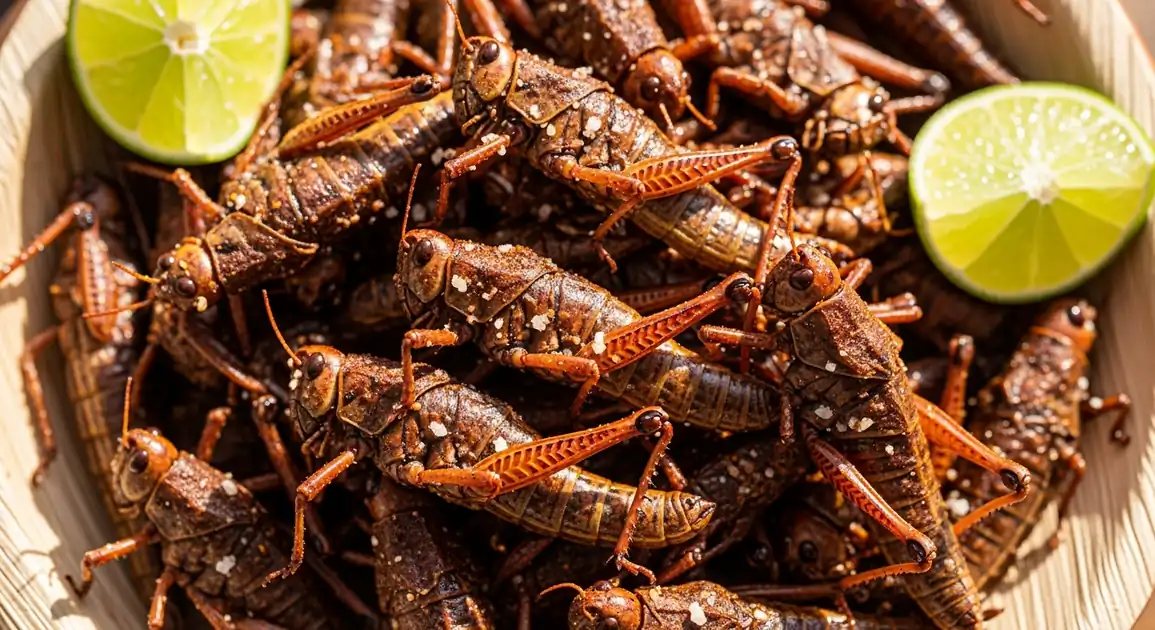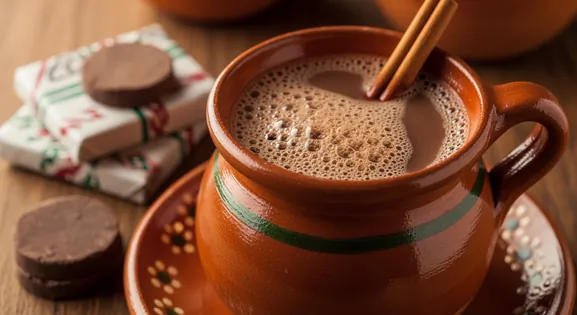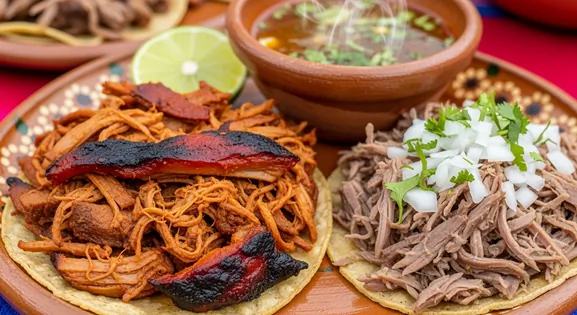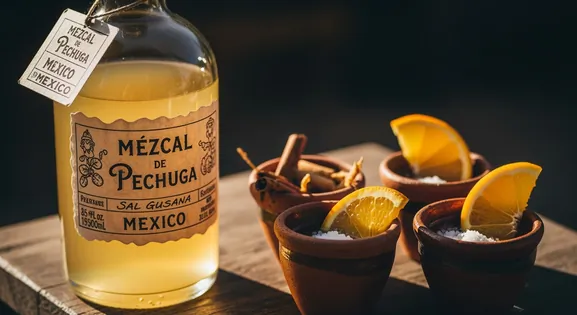Chapulines (Toasted Grasshoppers) in Oaxaca
Chapulines

The Essential Guide to Chapulines (Toasted Grasshoppers)
Stepping into Oaxaca, the aroma of toasted chapulines is unmistakable. These crunchy, seasoned grasshoppers are more than just a snack; they're a culinary cornerstone, deeply woven into the city's vibrant food scene and indigenous heritage. Prepare to embark on a unique gastronomic adventure!
New to Chapulines (Toasted Grasshoppers)? Learn all about its history in our complete guide.
Key Tips for Enjoying This Dish
Many vendors use large clay griddles (comales) for toasting, which imparts a superior, smoky flavor and ensures even crispness. Ask for "chapulines de comal" for the best quality.
Chapulines are the quintessential accompaniment to Oaxaca's famous mezcal. Many mezcalerías offer them as a complimentary botana (snack), enhancing the tasting experience.
While delicious on their own, don't miss chapulines incorporated into local dishes like tlayudas, memelas, or even mole. It adds a unique texture and earthy flavor.
A Traveler's Checklist
What to Look For
-
Vendors in major markets like Benito Juárez or 20 de Noviembre
These markets are central hubs for chapulines with high turnover and experienced vendors.
-
Chapulines sorted by size and seasoning
Indicates care in preparation; vendors often offer small ('chicos'), medium ('medianos'), large ('grandes'), and different seasonings (natural, con ajo, con chile).
-
Completely dry, brittle texture – should snap easily
Crucial indicator of thorough toasting, essential for safety and shelf life in Oaxaca's climate.
-
Vibrant reddish color (from chile/seasoning) without burnt pieces
A vibrant reddish color, often from chili and seasoning, indicates fresh preparation and proper toasting without any burnt or overcooked pieces.
What to avoid
-
Damp, soft, or flexible chapulines
Damp, soft, or flexible chapulines suggest insufficient toasting or moisture exposure, which can compromise their quality and freshness.
-
Piles with significant amounts of dust, debris, or legs/wings only
Piles containing significant amounts of dust, debris, or only legs/wings indicate poor cleaning practices or improper handling by the vendor.
-
Musty or off smell
Fresh chapulines should smell pleasantly of lime, garlic, and chile.
Ordering Like a Local
When buying chapulines in Oaxaca's markets, ask for a "medida" (a scoop) or specify a weight. Vendors often offer samples ("una pruebita") to check freshness and seasoning. Don't hesitate to try different sizes—small ones are often crisper, while larger ones have more chew. Specify your preferred seasoning, such as "con chile y limón" (with chili and lime) or "con ajo" (with garlic).
Exploring Oaxaca for the Best Chapulines (Toasted Grasshoppers)
Central de Abastos
Oaxaca's main market and the primary source for chapulines. Contains multiple specialized vendors with various sizes and preparations.
Dried goods section, Insect food vendors area
Early Morning (7 AM - 11 AM)
Mercado 20 de Noviembre
A vibrant food market where you can find numerous vendors specializing in chapulines, both for snacking and incorporated into delicious prepared dishes like tlayudas.
Dried foods section, Food stalls area
Morning to Afternoon (9 AM - 4 PM)
Around Zócalo (Main Square)
You'll find many tourist-oriented stands and shops selling chapulines, often in attractive, sealed packaging, perfect for souvenirs or immediate enjoyment while exploring the city center.
Streets surrounding the main square, Macedonio Alcalá pedestrian street
Afternoon to Evening (12 PM - 8 PM)
Mezcalerías in Centro Histórico
Bars specializing in mezcal typically serve quality chapulines as the traditional accompaniment, perfectly complementing the complex flavors of Oaxacan mezcal.
Mezcal bars throughout downtown, Restaurant zone
Evening (6 PM - 11 PM)
Vendor Tips
- Look for vendors who clearly sort their chapulines by size - this indicates care in preparation.
- Ask vendors about their toasting method; traditional clay comal toasting is considered superior.
- The best vendors will happily explain their seasoning mix, often a family recipe.
- Quality vendors clean their chapulines meticulously - there should be no visible debris.
What You Need to Know
Dietary Information
Important Note for Travelers: Your safety is our priority. Below are the common allergens associated with the traditional preparation of this dish. However, recipes and ingredients can vary significantly between establishments. Always confirm all ingredients directly with the food vendor before ordering, especially if you have a severe allergy.
Potential Allergens
Dietary Suitability
Price Guide
Budget Tips
- Markets like Central de Abastos offer the best prices (15-40 MXN for small portions).
- Prices vary by size - small chapulines are cheaper but more labor-intensive to prepare.
- Buying directly from producers at weekly markets (tianguis) often yields the best value.
- Tourist areas like around Zócalo charge premium prices (40-80 MXN for similar portions).
- Some restaurants charge 60-120 MXN when used as a featured ingredient in traditional dishes.
Serving & Seasonality
In markets, typically sold in small plastic bags with lime wedges. In restaurants, served in small clay dishes, often as an appetizer. Commonly incorporated into traditional dishes like tlayudas, memelas, and tacos. Almost always accompanied by lime wedges.Best Times to Enjoy
- Morning: Markets like Central de Abastos are best in the morning for freshly prepared batches.
- Afternoon: Popular in markets and street stands around the Zócalo and tourist areas.
- Evening: Featured in restaurants and mezcalerías, particularly as an accompaniment to mezcal tastings.
Seasonal Availability
Available year-round, but highest quality during and after rainy season (June-October) when fresh grasshoppers are most abundant.
Culture and Customs
Local Significance
In Oaxaca, chapulines are a profound cultural symbol representing indigenous culinary traditions, sustainability, and regional identity. They're not considered exotic but rather an everyday food deeply connected to local heritage.
Eating Customs
- Always served with lime wedges to squeeze fresh juice over them before eating.
- Often consumed as a protein-rich snack between meals.
- In traditional settings, eaten by hand directly from small clay dishes.
- Incorporated into countless local dishes, from simple street foods to complex moles.
Local Styles of Chapulines (Toasted Grasshoppers)
Size Grades
Oaxacan vendors meticulously sort chapulines by size: small (chicos), medium (medianos), and large (grandes), each with different culinary uses and prices.
Traditional Seasoning
The classic Oaxacan preparation uses garlic, lime, salt, and mild chile, with some families adding a touch of agave worm salt (sal de gusano) or specific local herbs.
Chapulines for Tlayudas
Specifically prepared smaller chapulines intended as a topping for Oaxaca's iconic large tortillas with assorted toppings.
Valley Variations
Slight preparation differences exist between the Central Valleys, the Mixteca region, and the Sierra Norte, with varying amounts of chile and herb additions.
Mastering the Experience
Buying Chapulines Like a Local in Oaxaca Markets
Learn how to navigate Oaxaca's bustling markets and confidently purchase the freshest, most authentic chapulines directly from local vendors, ensuring a delicious and safe experience.
- Visit Mercado Benito Juárez or 20 de Noviembre for the widest selection.
- Observe different vendors; notice how they sort by size (small, medium, large) and seasoning.
- Ask for 'chapulines con chile y limón' (common) or 'con ajo' (with garlic). Natural versions are also available.
- Request a sample ('una pruebita') to check crispness and taste before buying a larger quantity ('una medida' - a measure/scoop, or by weight).
- Confirm the price per 'medida' or kilo.
Eating Chapulines in Oaxaca
Discover the various ways Oaxacans enjoy chapulines, from simple snacks to integral ingredients in traditional dishes, and learn the local etiquette for savoring this unique delicacy.
- Eat them plain as a crunchy snack, often accompanied by mezcal or beer.
- Sprinkle them over tlayudas, guacamole, or tacos for added protein and flavor.
- Be adventurous but start small if you're hesitant.
- Understand they are a respected, traditional food source, not just a novelty.
- Purchase from reputable market vendors rather than informal street sellers for better quality control.
Our Commitment to Quality
At Tasteplorers, our mission is to provide the most accurate and useful travel information in the world. To achieve this, all content on this site is created through our unique editorial framework. We utilize leading AI research tools, guided by our proprietary prompts, and a multi-stage validation process. This entire system is overseen by our editorial team to ensure everything we publish meets our high standards for accuracy, cultural nuance, and practical value for travelers.
Learn more about our Editorial Process and our Mission.
Explore regions
Europe
Discover Europe's diverse culinary landscape, from Mediterranean flavors to hearty Alpine fare. Learn to navigate markets, decode menus, and eat like a local.
Latin America & Caribbean
Discover the vibrant cuisines of Latin America & the Caribbean. Our expert guide covers everything from Mexican street food to Peruvian ceviche and market tips.
Oceania
Explore Oceania's diverse food scene. Learn about Polynesian earth ovens, Fijian feasts, and the vibrant café culture of Australia and New Zealand.
Southeast Asia
Explore Southeast Asia's diverse food cultures from Thailand to Vietnam. Get expert tips on navigating spice levels, choosing quality vendors, and understanding the rich traditions of the region.



